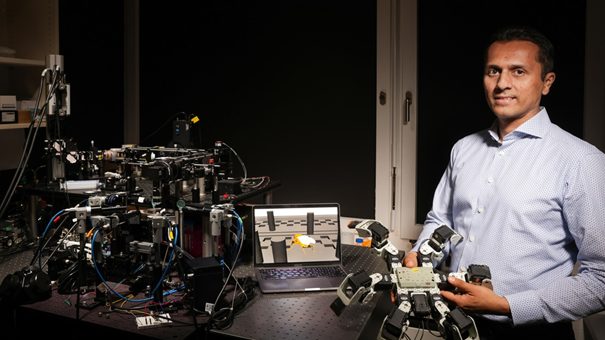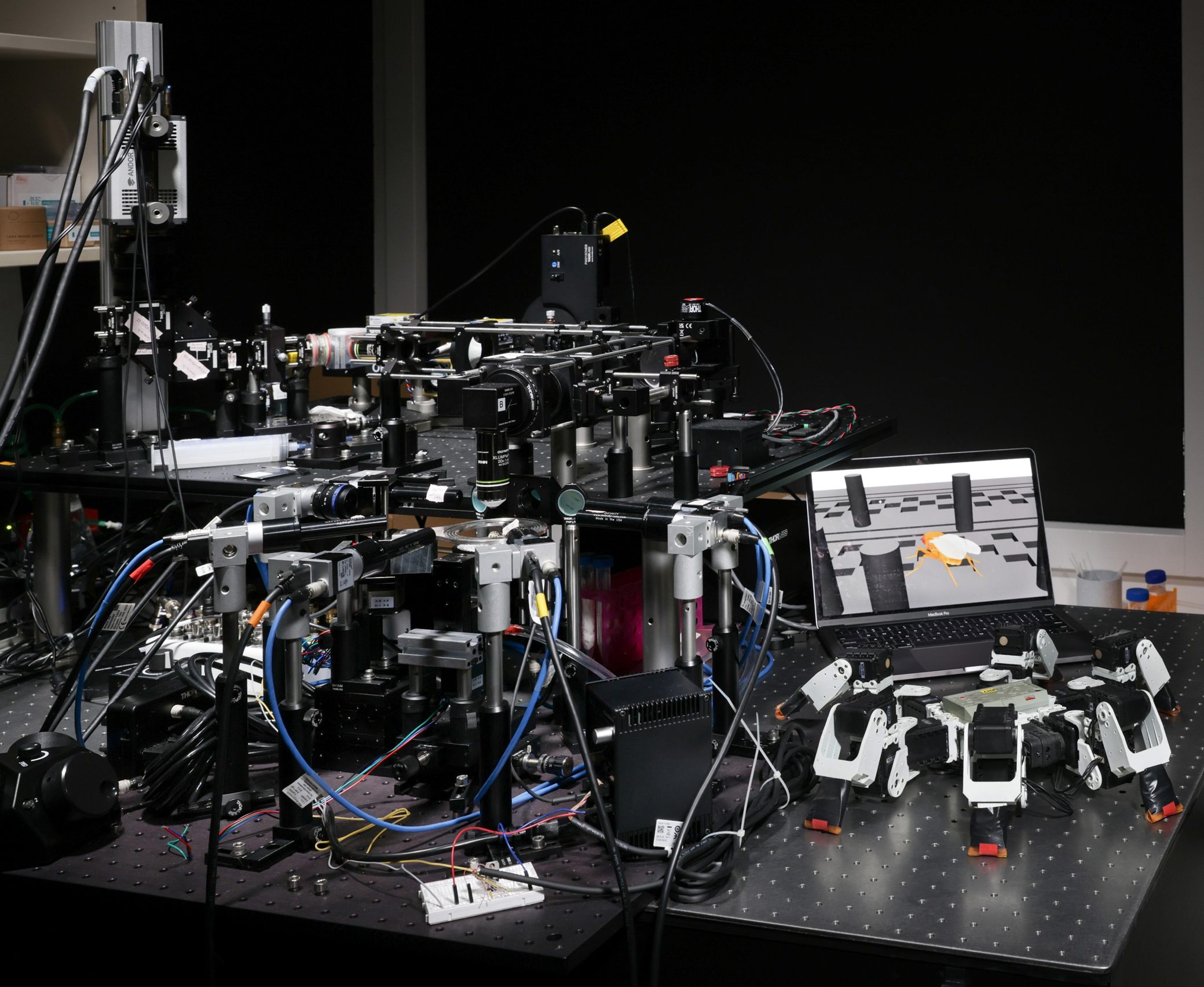Researchers at EPFL’s Neuroengineering Laboratory, led by Pavan Ramdya, aim to replicate the workings of the brain of the common fruit fly, Drosophila melanogaster. We spoke with Ramdya about the exciting prospects for robotics.

On the screen, white on a black background, a fly is magnified thousands of times and walks calmly across a spherical surface on its six legs. “Watch, in a second it’ll do the moonwalk.” We are in the heart of the EPFL Neuroengineering Laboratory with Pavan Ramdya, head of the lab, and a postdoctoral researcher, Maite Azcorra. She shines tiny focused pulses of laser light at the fly using a technique known as optogenetics, which uses light to activate specific neurons. As if on command, the fly moves its legs backwards. And it looks just like a dance.
Ramdya’s 14-person research group has been studying the nervous system of these two-millimeter-long insects since 2017. “Maite is currently studying how neurons that descend from the brain control motor functions,” says Ramdya. The group hopes to eventually reverse-engineer the fly’s brain and to model it for robotics. One major step forward was the development of a digital twin that the researchers can use to accurately simulate a fly’s behaviors; another was an important breakthrough in understanding how neural networks turn brain signals into coordinated movements. We sit down in the office of the New York-born neuroscientist to talk about his work.
Can you describe the general idea behind your research program?
Humans have been trying for centuries to build machines that can behave like animals or people. In Ancient Greece, for example, automated marionettes were quite common – these were simple objects but they were already a form of biomimetics, in that they imitated how an actual body moves. That’s the same idea we’re pursuing here, except that we use far more advanced methods and systems that can truly bio-mimic animals like the fruit fly.
Why are you studying Drosophila melanogaster specifically?
There are more complicated animals of course, like mammals, but they’re harder to study. And there are simpler ones like C.elegans , a worm with only around 300 neurons [flies have around 100,000 and humans have approximately 86 billions] but we can’t learn as much about behavior from them. Unlike worms, flies have legs, and they do a lot with them – walk around, clean themselves, manipulate obstacles and more. It’s much more interesting for applications in robotics and neuroprosthetics to know how a creature with both wings and legs works. They’re perfect specimens from that perspective: simple enough to study, yet complex enough to offer many insights.
In your recent TEDx talk, you said that in the future robots used to explore and colonize new planets might look a lot like these flies.
Yes, robots for space exploration will need to complete numerous tasks on their own and make decisions autonomously while moving in unknown, hostile environments. Engineers have been working to build such robots for decades, but for now, even the most sophisticated machines have nowhere near the agility of the fruit fly. Flies can do incredible things. Not only can they fly, they’re also extremely stable owing to their six legs. They can move in all three dimensions while performing other tasks with their legs. They’re a major source of inspiration!
How might the work you’re doing influence the development of robotics and AI?
Many engineers are working on the hardware side of robots – for example, batteries and motors. That’s not our focus. We’re seeking to design their controllers. With the idea of developing a robotic fly, our main point of interest is to understand how it can control its limbs. That’s why we’re studying the fruit fly’s nervous system – to gain insights that will help us develop neural networks that can be used in robotics and AI. I’d also point out that the robots using these controllers don’t have to be the size of a fly. As long as it is scaled appropriately, they can be any size – even as big as a house, although that would be a little scary!
But your research includes other aspects, too.
That’s right. One unique characteristic of flies is that their legs are covered with mechanical sensors. How do flies use all the information they gather to understand their environment and detect objects around them? How do they decide when to lift one or more of their legs over obstacles? Those are the kinds of questions we want to answer. And to do that, we’re trying to develop materials patterned after the fly cuticle with integrated sensors that can be used in robots.
Many robotics and AI experts have said that to create machines genuinely capable of learning, the machines must have bodies that can move around and explore their environment.
Yes, that’s a central theory held by scientists studying neurobiology and behavior. And it should be a central theory in AI too, since animals can behave more flexibly than robots. Engineers working in machine learning often point out that human babies constantly move around and touch things, exploring their surroundings to learn about the world around them. This process is much more effective than if we just presented them with videos of their environment. The sensors I mentioned earlier – those on flies – also serve this purpose.

What are currently the biggest hurdles to developing systems that can learn by exploring their environment?
One hurdle is to create algorithms that can process sensory data. If they can’t contextualize these data, it would be very difficult for machines to learn to learn the appropriate behaviors. It’s important to stress that the solution does exist – it’s just hidden in animals’ nervous systems. That’s what we’re trying to uncover. Instead of spending decades attempting to design a solution from scratch, why not look at what already exists in flies?
Will that necessarily be an easier and faster approach?
What we’ll probably need is a combination of different approaches. Especially since animals have a lot of constraints and objectives that aren’t relevant for our purposes. For instance, robots don’t need to be able to reproduce or defecate. That’s why we must also include biologists in our work and not just engineers. They are better able to know which parts of an organism we can ignore, such as neurons used to evacuate food, so that engineers don’t focus on them. An interdisciplinary approach is essential for the work that we’re doing.
Is the goal to eventually map the human brain?
I’ll have to give you a selfish answer: for me, personally, that’s not my goal. I have around 40 more years to live if I’m lucky, and I’d really like to see major breakthroughs in my lifetime that could show how biological systems work. That seems possible with the fruit fly, but it would be far more complicated for the human brain. Perhaps it’s just a matter of scale – maybe we simply need to take a fly’s brain and multiply it by a million. That might give us something intelligent and would certainly be very interesting. But I’m not sure that it would capture human intelligence. I don’t think we could use exactly the same approach for the human brain as for the fruit fly, because it would take too long.
How is your approach to neuroscience different from that of other neuroscientists?
In neuroscience, I’d say that over 99% of people are working on topics related to human health and medicine. Most studies that examine how neuroscience can inform the treatment of a disease, for instance, are carried out using mice or rats, because they’re mammals like us. I think what our research group is doing can shift people’s perspectives in two ways. First, we look at neuroscience not just in terms of human health, but rather in how it can be applied in robotics to build machines in new ways. And secondly, we draw attention to the smaller fraction of neuroscientists studying insects. We should keep in mind that many of the insects on our planet are under threat. Look at bees, and the important role they play in pollination. It’s a critical issue. Fruit flies aren’t a threatened species but they can provide insight into ones that are, helping to support conservation efforts. This can encourage people to view the world from a more eco-systemic perspective and appreciate the vital contribution made by biodiversity.
BIO
Pavan Ramdya was born in New York City in 1979 and grew up on Long Island. He’s been interested in robotics ever since he was a child: “I always wondered whether we’d one day be able to build something that looks and acts like a human. It fascinated me.” he says.
Upon applying to university, Ramdya initially planned to go into medicine – “when you’re an American of Indian origin, you’re often expected to become either a doctor or an engineer,” he says with a smile. But while preparing his application to study medicine, he changed his mind and focused on neuroscience. He obtained a bachelor’s degree from Drew University, followed by a PhD from Harvard University in 2009.
Ramdya came to Lausanne for his postdoctoral research – which is when he began studying fruit flies and robotics – under Richard Benton at the University of Lausanne and Dario Floreano at EPFL. After spending two years as a researcher at Caltech, Ramdya returned to EPFL in 2017 as a professor of Neuroscience and Bioengineering and as head of the Neuroengineering Laboratory.
When Ramdya isn’t in the research lab, he may be playing the Fender Jazz Bass guitar that sits proudly in his office. “When I was younger I jammed a lot. I played rock – Led Zeppelin and other groups like that,” he says. “Now I play whenever I have the time. I like all kinds of music.” Does his groove match his talents as a scientist? You can find out today, on 4 April, when he’ll be performing at the Polydôme with the SV Band.
Author: Gregory Wicky
Source: EPFL